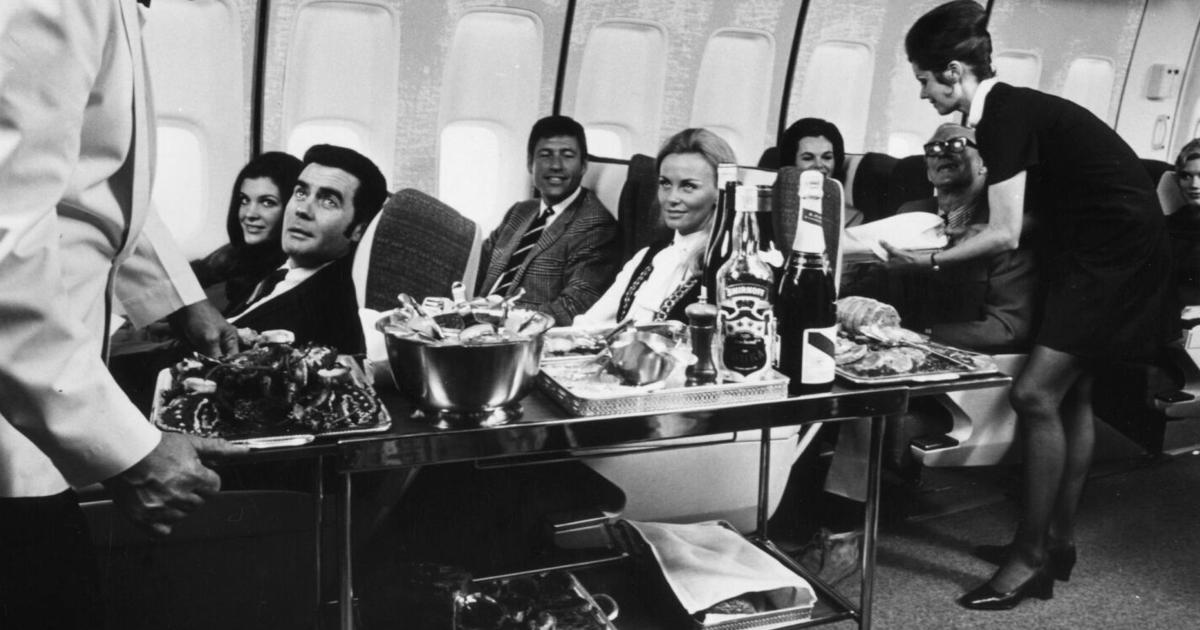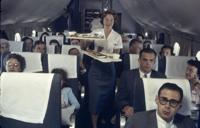New York (CNN) — If you took an American Airlines flight in the 1960s, you’d be wined and dined from the Coach-class “Royal Coachman” menu. Your meal began with the beef consommé and proceeded to sautéed breast of chicken in wine. Care for a fruit tartlet for dessert?
Today, if you’re flying coach, you’ll need to book a long-distance international flight or – maybe if you’re lucky – a coast-to-coast domestic one to receive a free meal. On shorter flights, you might get a choice of complementary Biscoff cookies or pretzels.

A Pan American Airline flight attendant serves trays of food to passengers on a plane in 1958.
Airplane meals have fallen a long way from the glory days of in-flight dining when airlines served white-tablecloth dinners and stewardesses scrambled eggs in the air. Disappearing meals have joined a long list of pain points, inconveniences and cutbacks travelers endure when they fly today. But industry cost-cutting isn’t the only reason your tartlet is gone. The end of in-flight dining for many passengers follows sweeping changes in government regulation, airplane design, in-flight entertainment, industry tax breaks, plus heightened health and safety concerns.
Airline safety protocols and regulations since September 11 have changed what types of cooking knives crews can work with in the air. Airplane galleys are smaller to allow for more passenger seats on a plane. And airlines don’t serve some foods, like peanuts, to protect people with allergies. So meals are often smaller, more bland or non-existent.
“Meal service was once a point of pride,” said Henry Harteveldt, who covers the travel industry for Atmosphere Research Group. Now, “the quality is so poor you have to wonder: Do airline executives actually have taste buds?”
Airlines have long looked for ways to cut food production costs and reduce meal preparation times for flight attendants on board. In one famous example during the 1980s, Robert Crandall, then the head of American Airlines, bragged about how removing just one olive from every salad saved the airline $40,000 a year.
Cost and speed became more important to airlines than how the food tastes ever since. Carriers like Singapore Airlines or Delta may have partnerships with Michelin-starred celebrity chefs, but most companies farm out their food to catering services who may prepare it hours ahead.
“People are willing to trade food for low fares,” said Blaise Waguespack, a professor of airline marketing at Embry‑Riddle Aeronautical University in Daytona Beach, Florida. “Your ticket gets you the seat. And anything beyond the seat you pay for.”
Charging passengers for food on board – even just a few dollars for a sandwich, snack box or cheese plate – is also a way for airlines to save on taxes. Domestic airfares are subject to a 7.5% federal excise tax, but that tax doesn’t apply to baggage fees and on-board food, both of which are getting more expensive.
Caviar and free chewing gum
Food on planes has been around almost a century, ever since 1920s flight attendants handed out chewing gum to passengers to relieve pressure in their ears. Early airplanes bounced so much in flight that meals were served on paper plates, according to the Smithsonian.
For decades, the federal government regulated airfare and routes, so airlines tried to set themselves apart with service, food and the kind of luxury usually afforded cruise passengers – or a Bond villain.
Until 1978, when the airline industry was deregulated, the law required that every passenger got an entrée, two vegetables, a salad, dessert and a drink as part of their ticket price, according to the Smithsonian.
“Delicious food adds to the enjoyment. It’s prepared in four simultaneously operating galleys, where dishes can be cooked in five-minute ovens,” Pan Am advertised in a 1958 commercial.
During the 1960s and 1970s, airlines routinely installed sky-high kitchens on board and advertised their menus to draw customers.
Beef was a business strategy.
”Airlines competed on service and amenities. Meal service was a big focus of [competition] because entertainment options were more limited,” Harteveldt said. “Airlines would have teams of chefs, their own catering kitchens [and] advertising around food.”
As deregulation took hold, airlines cut ticket prices. But to make up for lost revenue, they cut back on food choices and other services as well.
The September 11 attacks accelerated the decline of free airline meals. Airlines faced a deep reduction in demand and slashed in-flight meal service in response. United, American Airlines, Delta and others announced sharp reductions in-flight meal service shortly after the attacks.
The last holdout, Continental Airlines, became the final major airline to end free domestic meals in economy class in 2010.
Airline meals had been the brunt of jokes and criticism for decades, but now people miss them. Few airline-industry experts see them coming back anytime soon in coach.
The reality is very different for business and first-class passengers.
Molly Brandt, the executive chef of culinary innovation for North America at in-flight catering company Gategroup, said that the “golden age for airline food is here.” It just depends on which airline you’re flying and category you’re in. “It’s broken down by cabin class,” she explained.
If you’re in first class on an American flight, for example, you may have a lunch choice of a Mediterranean bowl, chicken breast with mojo sauce, Poblano black bean rice and plantains or penne pasta with plant-based ragu and ricotta. For Delta, pick between the cheeseburger, the spinach and cheese agnolotti, or a Hempler’s smoked peppered chicken breast salad.
A handful of airlines even offer caviar to first class passengers. But most fliers these days don’t even get the free chewing gum.
The-CNN-Wire™ & © 2024 Cable News Network, Inc., a Warner Bros. Discovery Company. All rights reserved.


